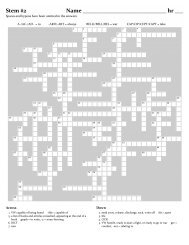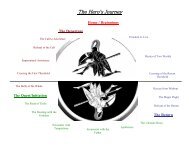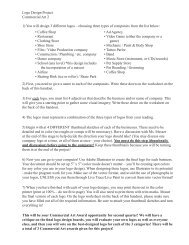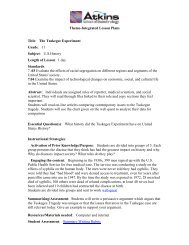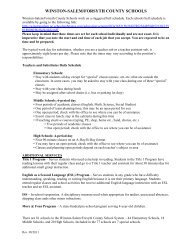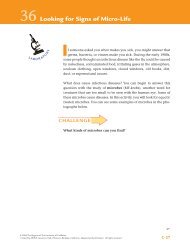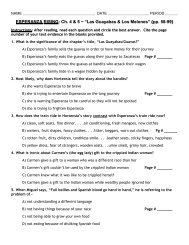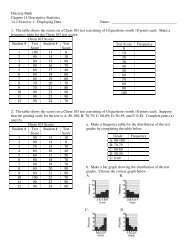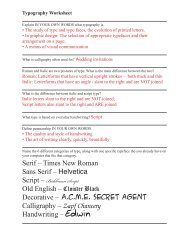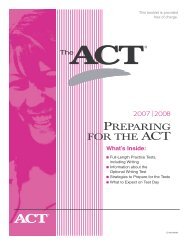Activity 2 • The Pellagra Story
Activity 2 • The Pellagra Story
Activity 2 • The Pellagra Story
Create successful ePaper yourself
Turn your PDF publications into a flip-book with our unique Google optimized e-Paper software.
2 <strong>The</strong> <strong>Pellagra</strong> <strong>Story</strong><br />
V<br />
I E W<br />
A N D<br />
R E F L E C T<br />
Scientists have common approaches to solving problems. Usually,<br />
people think of experiments as one way scientists investigate<br />
problems. What kinds of experiments are possible when you study<br />
human beings How can you collect evidence in these situations Begin<br />
to consider these issues as you watch the story of the disease called pellagra<br />
(puh-LAY-gra), which affected poor rural families of the South.<br />
Whenever you see this icon, it means that you will find more information<br />
or a technology extension on this subject on the SALI page of the<br />
SEPUP website.<br />
CHALLENGE<br />
What are the common elements shared by all scientific problemsolving<br />
methods How is science used to study people<br />
PROCEDURE<br />
1. In order to prepare to watch the story on the video, first read<br />
Analysis Questions 1–4.<br />
2. Your teacher will provide you with a student sheet or ask you to<br />
prepare a table like Table 1 on the next page to record your notes<br />
during the video.<br />
3. Watch the story of pellagra on the video, A Science Odyssey: “Matters<br />
of Life and Death.”<br />
A-8<br />
© 2006 <strong>The</strong> Regents of <strong>The</strong> University of California.<br />
Created by SEPUP, Lawrence Hall of Science, Berkeley, California. Adapted with permission. All rights reserved.
<strong>The</strong> <strong>Pellagra</strong> <strong>Story</strong> • <strong>Activity</strong> 2<br />
Table 1: Notes on <strong>The</strong> <strong>Pellagra</strong> <strong>Story</strong><br />
What was the problem of pellagra<br />
What did people think caused pellagra<br />
1.<br />
2.<br />
3.<br />
4.<br />
What evidence did Dr. Goldberger observe or collect about pellagra<br />
What did Dr. Goldberger conclude about the cause of pellagra<br />
ANALYSIS<br />
1. a. What was the first step in Dr. Goldberger’s research into pellagra<br />
Explain why this step was important in developing his<br />
hypothesis.<br />
b. During this first step in his research, what evidence did Dr.<br />
Goldberger find that suggested that pellagra was not caused<br />
by germs<br />
2. a. What was Dr. Goldberger’s hypothesis about the cause of<br />
pellagra<br />
b. What did he do to provide evidence of the relationship between<br />
pellagra and nutrition Be sure to explain how his research provided<br />
evidence that supported or disproved his hypothesis.<br />
c. How could he have provided more convincing evidence of the<br />
relationship between pellagra and nutrition<br />
➢<br />
© 2006 <strong>The</strong> Regents of <strong>The</strong> University of California.<br />
Created by SEPUP, Lawrence Hall of Science, Berkeley, California. Adapted with permission. All rights reserved.<br />
A-9
<strong>Activity</strong> 2 • <strong>The</strong> <strong>Pellagra</strong> <strong>Story</strong><br />
3. Why didn’t people believe Dr. Goldberger’s conclusion about the<br />
cause of pellagra Give two reasons.<br />
4. Compare the steps of the traditional scientific method to the steps<br />
Dr. Goldberger followed to investigate pellagra. How were the steps<br />
the same How were the steps different<br />
5. To investigate his hypothesis, Dr. Goldberger had prisoners volunteer<br />
to be fed a poor diet; as a result, 7 out of 11 prisoners developed<br />
pellagra. What do you think about Dr. Goldberger’s decision to<br />
experiment on people Support your answer with evidence and<br />
identify the trade-offs of your decision.<br />
Hint: To write a complete answer, first state your opinion. Provide<br />
two or more pieces of evidence that support your opinion.<br />
<strong>The</strong>n consider all sides of the issue and identify the trade-offs of<br />
your decision.<br />
6. Reflection: How do people in different careers solve problems<br />
Scientists, plumbers, engineers, auto mechanics, nurses, teachers,<br />
and many other workers solve problems. Choose two careers that<br />
interest you. Describe the kind of problems you think people face<br />
in these careers. Describe how you think they solve them.<br />
A-10<br />
© 2006 <strong>The</strong> Regents of <strong>The</strong> University of California.<br />
Created by SEPUP, Lawrence Hall of Science, Berkeley, California. Adapted with permission. All rights reserved.



